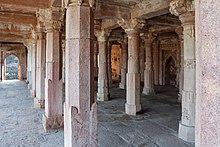| Dilawar Khan | |
|---|---|
| 'Amid Shāh Dā'ūd | |
 | |
| 1st Sultan of Malwa | |
| Reign | 1401–1406 |
| Coronation | 1401 |
| Predecessor | Position established (himself as Governor of Malwa) |
| Successor | Hoshang Shah |
| Governor of Malwa | |
| Reign | 1392–1401 |
| Predecessor | Post established |
| Successor | Position abolished (himself as Sultan of Malwa) |
| Died | 1406 Dhar Malwa Sultanate (present-day Madhya Pradesh, India) |
| Dynasty | Ghurid dynasty |
Dilawar Khan was a governor of the Malwa province of Central India appointed by the Delhi Sultan in 1392 [1] and he later became the first Sultan of the Malwa Sultanate during the decline of the Delhi Sultanate. [2] [3] After serving at the court in Delhi, he was appointed governor at Dhar in A.H. 793/C.E. 1390–91. Dilawar Khan took the title of 'Amid Shāh Dā'ūd and caused the khutba to be read in his name in A.H. 804/C.E. 1401–02, declaring himself independent and establishing the Malwa Sultanate. [4] He passed his kingdom – the Malwa Sultanate – to his son Hoshang Shah upon his death in A.H. 809/C.E. 1406. [5]
Dilawar Khan was a follower of Firuz Shah Tughluq's son, Muhammad ibn Firuz, later known as Muhammad Shah. [6] He was imprisoned by the court officials at Delhi for his support for the rebel prince. Not only Dilawar Khan, but many important provincial governors, such as that of Gujarat, and various other important and powerful nobles of the court supported the Prince's claim to the throne. After Timur's invasion in 1398, the same prince, who was the then Sultan of Delhi, ran away from the capital and sought shelter, first in the Gujarat Sultanate, but receiving a less than enthusiastic response there, moved to the Malwa Sultanate. Dilawar Khan is said to have welcomed him with open arms and told him that his Sultanate and treasure was all for the service of the Delhi Sultan. Dilawar Khan went to war with the Jaunpur Sultanate after its founder Malik Sarwar declared himself independent from Delhi however his forces were defeated and forced to retreat. [7]
References
- Citations
- ^ Michelsen, Leslee (5 September 2013). Ferozkoh: Tradition and Continuity in Afghan Art (English ed.). A&C Black. ISBN 978-99921-95-98-7.
- ^ Haig, T.W. & Islam, Riazul (1991). "Mālwā". In Bosworth, C. E.; van Donzel, E. & Pellat, Ch. (eds.). The Encyclopaedia of Islam, Second Edition. Volume VI: Mahk–Mid. Leiden: E. J. Brill. ISBN 978-90-04-08112-3.
- ^ Day (1965), pp. 8-24.
- ^ Day (1965), p. 21.
- ^ Tarikh-i-Muhammadi, and conclusions derived from U.N. DAY, Medieval Malwa.
- ^ Muhammad Bihamad Khani, Tarikh-i-Muhammadi, translated portions by Zaki Khan, CAS, Aligarh
- ^ Day, Medieval Malwa.
- Bibliography
- Day, Upendra Nath (1965). Medieval Malwa: a Political and Cultural History, 1401-1562. Delhi: Munshi Ram Manohar Lal. pp. 8–24. Retrieved 2 January 2012.